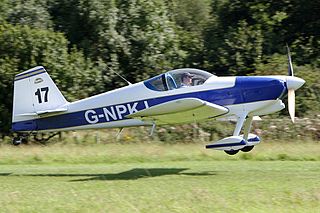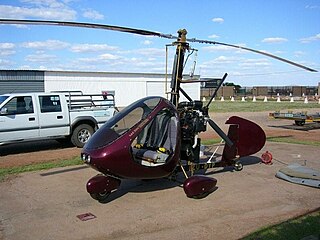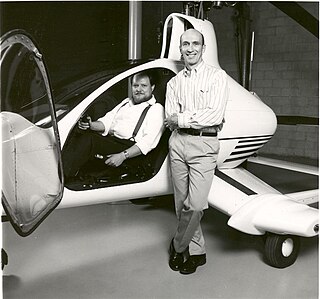Related Research Articles

A flying car or roadable aircraft is a type of vehicle which can function as both a personal car and an aircraft. As used here, this includes vehicles which drive as motorcycles when on the road. The term "flying car" is also sometimes used to include hovercars.

An autogyro, also known as a gyroplane or gyrocopter, is a type of rotorcraft that uses an unpowered rotor in free autorotation to develop lift. Forward thrust is provided independently, by an engine-driven propeller. While similar to a helicopter rotor in appearance, the autogyro's rotor must have air flowing across the rotor disc to generate rotation, and the air flows upwards through the rotor disc rather than down.

Juan de la Cierva y Codorníu, 1st Count of la Cierva was a Spanish civil engineer, pilot and aeronautical engineer. His most famous accomplishment was the invention in 1920 of a rotorcraft called Autogiro, a single-rotor type of aircraft that came to be called autogyro in the English language. In 1923, after four years of experimentation, De la Cierva developed the articulated rotor, which resulted in the world's first successful flight of a stable rotary-wing aircraft, with his C.4 prototype.

A gyrodyne is a type of VTOL aircraft with a helicopter rotor-like system that is driven by its engine for takeoff and landing only, and includes one or more conventional propeller or jet engines to provide forward thrust during cruising flight. During forward flight the rotor is unpowered and free-spinning, like an autogyro, and lift is provided by a combination of the rotor and conventional wings. The gyrodyne is one of a number of similar concepts which attempt to combine helicopter-like low-speed performance with conventional fixed-wing high-speeds, including tiltrotors and tiltwings.

The Van's RV-6 and RV-6A are two-seat, single-engine, low-wing homebuilt airplanes sold in kit form by Van's Aircraft. The RV-6 is the tail-wheel equipped version while the RV-6A features a nose-wheel. The RV-6 was the first aircraft in the popular Van's RV series to feature side-by-side seating and the first to offer a nosewheel option. It was first flown in 1985. Over 2700 kits have been completed and flown.

A rotorcraft or rotary-wing aircraft is a heavier-than-air aircraft with rotary wings or rotor blades, which generate lift by rotating around a vertical mast. Several rotor blades mounted on a single mast are referred to as a rotor. The International Civil Aviation Organization (ICAO) defines a rotorcraft as "supported in flight by the reactions of the air on one or more rotors".
Ira Donald “Don” Farrington was an American pilot and aviation entrepreneur famous for his knowledge of gyroplanes.

The Air & Space 18A is a gyroplane that was manufactured in the central United States between 1965 and 2000.

The Cierva C.8 was an experimental autogyro built by Juan de la Cierva in England in 1926 in association with Avro. Like Cierva's earlier autogyros, the C.8s were based on existing fixed-wing aircraft fuselages – in this case, the Avro 552.

The RAF 2000 is a two-seat kit built autogyro that was designed by Bernard J. Haseloh. Kits were first manufactured by Rotary Air Force Marketing Inc. in Canada. The marketing and manufacturing rights were sold to the Mocke Family in Upington, Northern Cape, South Africa in April 2007. They formed UMRTC Eben Mocke to produce the aircraft design.

The Preceptor N3 Pup is a family of ultralight, tube-and-fabric, high-wing, homebuilt aircraft. Kits were produced and marketed by Preceptor Aircraft, of Rutherfordton, North Carolina. The company was operating on a limited basis, actively selling plans online, but seems to have gone out of business in 2016.

The Autogiro Company of America AC-35 was an early attempt to make a roadable aircraft in the United States during the 1930s. Although it was successfully tested, it did not enter production; a 1960s attempt to revive the aircraft in a non-roadable version also failed to achieve success.

Skyworks Global, formerly Groen Brothers Aviation, Inc. and then Groen Aeronautics Corporation, is an American autogyro research and development company based in Salt Lake City, Utah. The company was founded in 1986 by David Groen and his late brother Jay Groen. David Groen remains as Senior Advisor.
The Farrington Twinstar is an American two-seat autogyro that was designed and produced by Farrington Aircraft of Paducah, Kentucky, a company owned by Don Farrington. Now out of production, when it was available the aircraft was supplied as a kit for amateur construction.

Little Wing Autogyros, Inc. is an American aircraft manufacturer based in Mayflower, Arkansas and founded by Ron Herron. The company specializes in the design and manufacture of autogyros in the form of plans and kits for amateur construction including for the US FAR 103 Ultralight Vehicles rules.
Raven Rotorcraft is an American aircraft manufacturer based in El Prado, New Mexico and formerly of Boulder Colorado. The company specializes in the design and manufacture of autogyros in the form of kits for amateur construction and reduction drives for three and four cylinder Geo Metro and Honda automotive engines for aircraft use.
Wombat Gyrocopters was a British aircraft manufacturer based in St Columb, Cornwall and founded in 1991 by Chris Julian. The company specialized in the design and manufacture of autogyros in the form kits for amateur construction.
The Calumet Snobird Explorer is an American autogyro produced by Calumet Motorsports of Lansing, Illinois, introduced in May 1997. Now out of production, when it was available the aircraft was supplied as a kit for amateur construction.
Calumet Motorsports is an American aircraft parts manufacturer and former aircraft manufacturer based in Lansing, Illinois and founded by Tom Milton. The company specializes in the design and manufacture of autogyro parts and at one time produced whole aircraft kits for amateur construction in the US FAR 103 Ultralight Vehicles category.
The GoFly Gotar is a French autogyro that was designed by and was under development by GoFly Aeronatique of Boves, Somme, introduced in 2013. The aircraft was intended to be supplied to customers complete and ready-to-fly.
References
- 1 2 3 Purdy, Don: AeroCrafter - Homebuilt Aircraft Sourcebook, Fifth Edition, page 323. BAI Communications, 15 July 1998. ISBN 0-9636409-4-1
- ↑ Federal Aviation Administration (March 27, 2015). "Make / Model Inquiry Results" . Retrieved March 27, 2015.
- ↑ "MIA00LA133". National Transportation Safety Board . Retrieved March 27, 2015.